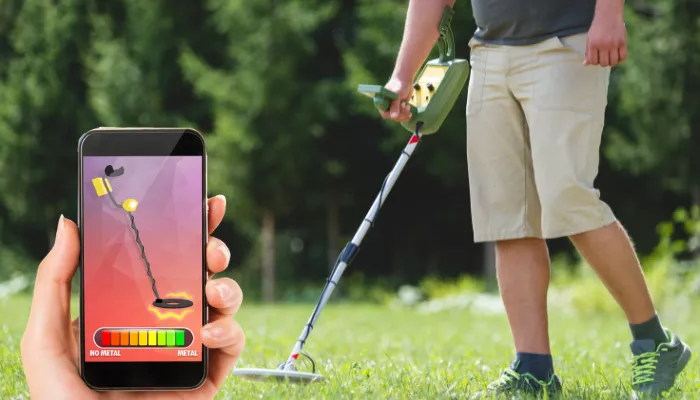Aplicativo detector de Metais – Desde a sua origem, os detectores de metais desempenharam um papel crucial na descoberta de relíquias históricas e tesouros enterrados.
Contudo, a revolução digital catapultou essas tradicionais ferramentas para uma nova era de acessibilidade e versatilidade.
A fusão entre a tecnologia de detecção de metais e os aplicativos móveis não apenas simplificou o processo, mas também democratizou o acesso a essa fascinante atividade.
Por fim, os detectores de metais agora funcionam em smartphones, transformando esses dispositivos em ferramentas de exploração poderosas.

Imagem Canva Pro – Google
Dos primeiros detectores rudimentares aos atuais aplicativos sofisticados, a evolução desta tecnologia é fascinante.
Antigamente, os entusiastas usavam dispositivos pesados e complexos para explorar o subsolo, mas a tecnologia móvel mudou completamente essa abordagem.
Atualmente, a detecção de metais está ao alcance de todos, na palma das mãos, graças aos avanços inovadores em aplicativos.
Hoje, a detecção de metais está ao alcance de todos, na palma das mãos, graças a avanços inovadores em aplicativos, tornando-a mais acessível do que nunca.
Os aplicativos detectores de metais utilizam o sensor magnético presente nos smartphone para identificar alterações no campo magnético ao seu redor.
Quando há a presença de um metal, a interferência nesse campo é detectada, alertando o usuário.
O uso inicial da tecnologia para calibrar sensores evoluiu para algo muito mais emocionante.
Enfim, originalmente projetada para calibrar os sensores do dispositivo, essa tecnologia foi astutamente ajustada, resultando em uma detecção de metais notavelmente precisa.
Além de detectar metais, os aplicativos modernos oferecem funcionalidades avançadas que impressionam e ampliam as possibilidades para usuários exigentes.
Destacam-se entre essas características a capacidade de identificar tipos específicos de metais, permitindo uma precisão excepcional na identificação de objetos enterrados.
Além disso, a possibilidade de ajustar a sensibilidade do detector oferece uma personalização fina, adaptando-se às diferentes condições de exploração.
Portanto, a integração desses aplicativos com tecnologias de realidade aumentada é outro avanço notável.
Os aplicativos detectores de metais têm encontrado aplicações surpreendentes em uma variedade de contextos.
Arqueólogos modernos utilizam essas ferramentas para descobrir artefatos enterrados, enquanto caçadores de tesouros amadores as usam em suas buscas por relíquias.
Além disso, esses aplicativos têm se mostrado úteis na vida cotidiana, ajudando as pessoas a encontrar itens perdidos, como chaves ou joias.
Além dos contextos históricos e de aventuras, esses aplicativos têm uma presença prática em nosso cotidiano.
Apesar dos avanços notáveis, os aplicativos detectores de metais ainda enfrentam desafios e limitações.
A precisão pode ser afetada por interferências externas, e nem todos os metais são detectáveis da mesma maneira.
Além disso, a durabilidade do sensor do smartphone pode ser um ponto de preocupação, especialmente para aqueles que fazem uso frequente desses aplicativos.
Além disso, a durabilidade do sensor do smartphone surge como uma preocupação legítima, especialmente para os usuários que exploram com frequência.
Olhando para o futuro, é evidente que a detecção de metais móvel continuará a evoluir.
Avanços na inteligência artificial e no processamento de dados têm o potencial de aprimorar ainda mais a precisão e a eficácia desses aplicativos.
Além disso, a integração com dispositivos de realidade virtual pode levar a uma experiência de detecção de metais mais imersiva e educativa.
A integração iminente com dispositivos de realidade virtual revela-se como um campo promissor.
Um exemplo notável na vasta gama de aplicativos detectores de metais é o “MetalFinder”.
Este aplicativo exemplar utiliza algoritmos avançados para não apenas identificar a presença de metais, mas também diferenciar entre diferentes tipos.
Ao buscar tesouros ou encontrar objetos perdidos, o “MetalFinder” oferece uma experiência intuitiva, ajustando a sensibilidade conforme o ambiente explorado.
Sua integração com realidade aumentada proporciona aos usuários uma visão virtual dos objetos detectados, criando uma experiência envolvente e informativa.